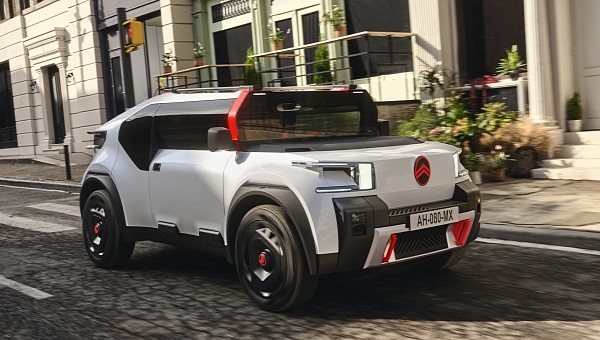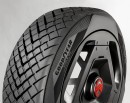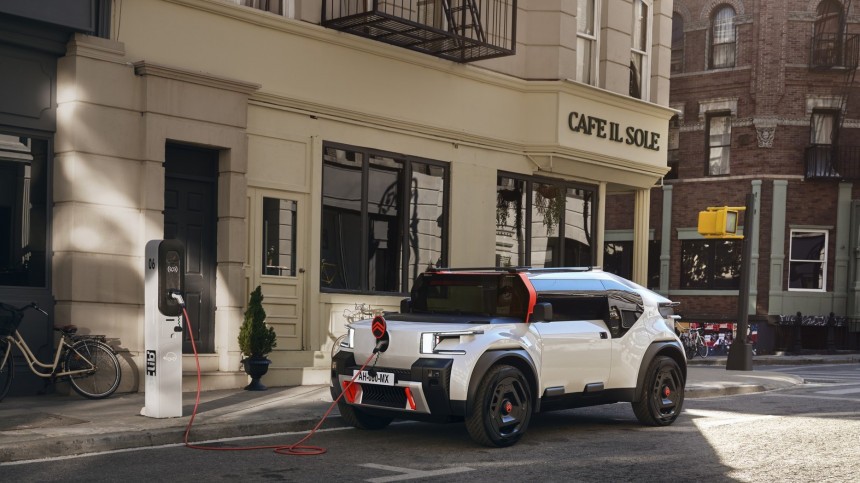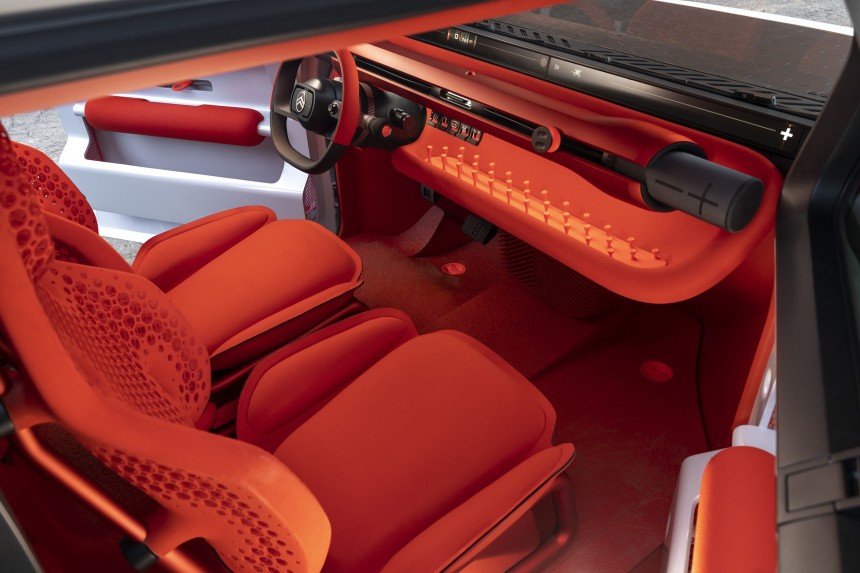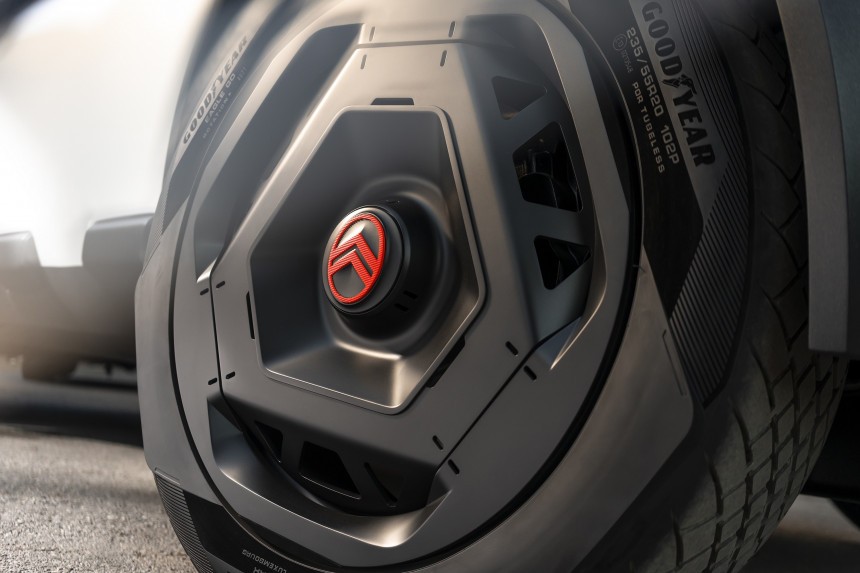It's not often that a concept car comes around that legitimately makes us go, "wow!" It's especially rare when said concept isn't a low-sprung sports car of some kind. But there's something about the Citroen Oli EV crossover concept that ignites our child-like wonder about automobiles in ways we don't often have the privilege of enjoying.
On first impressions, North American motorists are bound to find the quirky French Citroen Oli a bit of a joke. With dimensions that'd make a Ford EcoSport look like a Hummer H2 and a completely flat front windscreen seemingly straight out of a Tonka toy, there are reasons to suspect the average American commuter, in particular, would laugh at the little Oli. You know, the same way J.K. Simmons did in that meme scene from Spider-Man 2.
But it's precisely because the Citroen Oli would irritate North American and even some European motorists that we love the Citroen Oli around here. Simply for the fact that it tells the modern auto industry at large to go bleep itself. At a time when electric vehicles are getting larger, heavier, and more complicated to manufacture, the Oli takes all these negative conventions and throws them in the trash.
In an era of cars with smoother curves than the wings of a P-51 Mustang in spite of weighing more than ever, the Citroen Oli makes "slim-thick" electric crossovers from other brands look bloated, and, frankly, certifiably pudgy. We should never body shame human beings for any reason, man or woman, but automobiles are another can of worms entirely. In fact, some experts in the auto industry have begun sounding the alarm about how shockingly huge electric cars are quickly becoming.
We need not invoke the GMC Hummer EV, a vehicle that unapologetically breaks the scale at 9,000 lb (4,082 kg). But even on the less extreme side of things, EV SUVs like the Audi e-Tron Sportback and the BMW i7 still pack on the pounds in ways their equivalent ICE counterparts simply don't. If you ask the designers of the plucky little Oli, they'd probably tell you how backward and silly all of that sounds.
With body panels made in part of special cardboard-like honeycomb material bonded together with a substance similar to polyurethane, the Oli bucks the trend of new EVs needing large chunks of metal taking up every piece of its construction not occupied by leather, glass, or plastic. Admittedly, Citroen's decision to include the word "cardboard" in the name of their lightweight build material is a dubious one. But aside from that little foible, this material has real potential.
With a similar tensile strength to metal alloys like automotive-grade aluminum or steel, the Oli proves the modern automotive establishment chooses to build heavier cars rather than do it out of obligation with all the technology crammed inside. This same approach applies to the inside of this modern take on classic quirky French design.
With bare-exposed seat rails on display free of bulky wires and plastic molding, it almost gives the same aesthetic as a racing roll cage in a rally car. The seats on top of these mounts are cleverly designed as well. With a funky honeycomb three-piece composite seat design that saves loads of weight over standard seats, while also looking stylish in ways leather seats simply can't. If minimalism is the name of the game, the Oli's dashboard doesn't disappoint.
Think the Mustang Mach-E's 15.5-inch front infotainment display is vulgar? Well, the Oli ditches the front screen entirely. At least, it does in concept form. But the Oli concept's strict adherence to minimalist design is no less admirable. Nobody really needs a huge touch screen in their car. Just use your phone, for crying out loud!
Indeed, it takes a company with real cojones to release a concept car with a claimed range of just under 400 km (248 m) on a single charge from a 40 kWh battery when most manufacturers don't touch anything under a 50 or 60 kWh range apart from city cars. But in an era where the bulk of the electric grid worldwide comes from hydrocarbon fuels, it's good to know it's possible to make more out of less.
Indeed, if people decided to take it seriously, the Citroen Oli could profoundly change the way people worldwide drive. It puts an emphasis on long-term sustainability that most manufacturers only pretend to care about. But is the Oli really going to change the world? Probably not. Do you really expect GM, Ford, VW, BMW, and Mercedes-Benz to ditch their long-term plans to downsize and minimalize their lineup? Not a chance.
This is especially true in America, where manufacturers have been skirting regulations offering full-sized SUVs and light trucks to average suburbanites over smaller sedans and station wagons for decades. In truth, titans like Ford and VW are bound to look at the Citroen Oli and find it little more than mildly amusing.
There's money to be made pushing gigantic land barges of EVs loaded with every feature under the sun. A lot more than there is building a sensible alternative. On the face of it, we wouldn't want to see what would happen if a GMC Hummer EV t-boned one of these little Citroens. It'd probably be ripped in half like tissue paper. But that's not the fault of the Oli, but rather the fault of automakers that place profits over sustainability 99 times out of 100.
We can indeed build EVs that global resource supplies can sustain, and the Oli is proof positive. To see that the auto industry as a whole is going in the exact opposite direction should be nothing short of disturbing. Keep in mind we're not saying that Citroen alone is righteous in its innovative designs. Although, you can't help but get a little bit of an old Citroen DS vibe from the kind of innovation on display.
Rather, what we're saying is that the global auto sector is indeed capable of building minimalist, affordable, reliable cars that people actually want to buy. They're just choosing not to for their own respective reasons. If you ask us, that's a little sad.
But it's precisely because the Citroen Oli would irritate North American and even some European motorists that we love the Citroen Oli around here. Simply for the fact that it tells the modern auto industry at large to go bleep itself. At a time when electric vehicles are getting larger, heavier, and more complicated to manufacture, the Oli takes all these negative conventions and throws them in the trash.
In an era of cars with smoother curves than the wings of a P-51 Mustang in spite of weighing more than ever, the Citroen Oli makes "slim-thick" electric crossovers from other brands look bloated, and, frankly, certifiably pudgy. We should never body shame human beings for any reason, man or woman, but automobiles are another can of worms entirely. In fact, some experts in the auto industry have begun sounding the alarm about how shockingly huge electric cars are quickly becoming.
We need not invoke the GMC Hummer EV, a vehicle that unapologetically breaks the scale at 9,000 lb (4,082 kg). But even on the less extreme side of things, EV SUVs like the Audi e-Tron Sportback and the BMW i7 still pack on the pounds in ways their equivalent ICE counterparts simply don't. If you ask the designers of the plucky little Oli, they'd probably tell you how backward and silly all of that sounds.
With a similar tensile strength to metal alloys like automotive-grade aluminum or steel, the Oli proves the modern automotive establishment chooses to build heavier cars rather than do it out of obligation with all the technology crammed inside. This same approach applies to the inside of this modern take on classic quirky French design.
With bare-exposed seat rails on display free of bulky wires and plastic molding, it almost gives the same aesthetic as a racing roll cage in a rally car. The seats on top of these mounts are cleverly designed as well. With a funky honeycomb three-piece composite seat design that saves loads of weight over standard seats, while also looking stylish in ways leather seats simply can't. If minimalism is the name of the game, the Oli's dashboard doesn't disappoint.
Think the Mustang Mach-E's 15.5-inch front infotainment display is vulgar? Well, the Oli ditches the front screen entirely. At least, it does in concept form. But the Oli concept's strict adherence to minimalist design is no less admirable. Nobody really needs a huge touch screen in their car. Just use your phone, for crying out loud!
Indeed, if people decided to take it seriously, the Citroen Oli could profoundly change the way people worldwide drive. It puts an emphasis on long-term sustainability that most manufacturers only pretend to care about. But is the Oli really going to change the world? Probably not. Do you really expect GM, Ford, VW, BMW, and Mercedes-Benz to ditch their long-term plans to downsize and minimalize their lineup? Not a chance.
This is especially true in America, where manufacturers have been skirting regulations offering full-sized SUVs and light trucks to average suburbanites over smaller sedans and station wagons for decades. In truth, titans like Ford and VW are bound to look at the Citroen Oli and find it little more than mildly amusing.
There's money to be made pushing gigantic land barges of EVs loaded with every feature under the sun. A lot more than there is building a sensible alternative. On the face of it, we wouldn't want to see what would happen if a GMC Hummer EV t-boned one of these little Citroens. It'd probably be ripped in half like tissue paper. But that's not the fault of the Oli, but rather the fault of automakers that place profits over sustainability 99 times out of 100.
Rather, what we're saying is that the global auto sector is indeed capable of building minimalist, affordable, reliable cars that people actually want to buy. They're just choosing not to for their own respective reasons. If you ask us, that's a little sad.
